Important Questions of Carbon and its Compounds Class 10 Science Chapter 4
Question 1.
Covalent compounds have low melting and boiling point. Why? (2020)
Answer:
Covalent compounds have low melting and boiling points because the forces of attraction between molecules of covalent compounds are very weak. On applying a small amount of heat these molecular forces break.
Question 2.
What are covalent compounds? Why are they different from ionic compounds? List their three characteristic properties. (Delhi 2016)
Answer:
Covalent compounds are those compounds which are formed by sharing of valence electrons between the atoms e.g., hydrogen molecule is formed by mutual sharing of electrons between two hydrogen atoms.
They are different from ionic compounds as ionic compounds are formed by the complete transfer of electrons from one atom to another e.g., NaCl is formed when one valence electron of sodium gets completely transferred to outer shell of chlorine atom. The characteristic properties of covalent compounds are:
(i) They are generally insoluble or less soluble in water but soluble in organic solvents.
(ii) They have low melting and boiling points.
(iii) They do not conduct electricity as they do not contain ions.
Question 3.
What are covalent bonds? Show their formation with the help of electron dot structure of methane. Why are covalent compounds generally poor conductors of electricity? (Delhi 2013C)
Answer:
Covalent bonds are those bonds which are formed by sharing of the valence electrons between two atoms. Electron dot structure of methane is shown in the figure.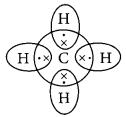
Covalent compounds are generally poor conductors ol electricity because they do not have tree electrons or ions.
Question 4.
Give reasons for the following:
(i) Element carbon forms compounds mainly by covalent bonding.
(ii) Diamond has high melting point.
(iii) Graphite is a good conductor of electricity. (3/5, Foreign 2011)
Answer:
(i) As carbon has four valence electrons and it can neither loose nor gain lour electrons thus, it attains noble gas configuration only by sharing of electrons. I bus, it forms covalent compounds.
(ii) In diamond, each carbon atom is bonded to four other carbon atoms forming a rigid three-dimensional structure. This makes diamond the hardest known substance. Thus, it has high melting point.
(iii) In graphite, each carbon atom is bonded to three other carbon atoms by covalent bonds in the same plane giving a hexagonal array. Thus, only three valence electrons are used for bond formation and hence, the fourth valence electron is free to move. As a result, graphite is a good conductor of electricity.
Question 5.
What is methane? Draw its electron dot structure. Name the type of bonds formed in this compound. Why are such compounds
(i) poor conductors of electricity and
(ii) have low melting and boiling points?
What happens when this compound burns in oxygen? (Delhi 2019)
Answer:
Methane is the first member of alkane series having formula CH4.
Refer to answer 3.
(ii) Refer to answer 1.
When methane is burnt in presence of oxygen then carbon dioxide will be produced.
CH4 + O2 → CO2 + H2O + heat + light
Question 6.
Elements forming ionic compounds attain noble gas electronic configuration by either gaining or losing electrons from their valence shells. Explain giving reason why carbon cannot attain such a configuration in this manner to form its compounds. Name the type of bonds formed in ionic compounds and in the compounds formed by carbon. Also explain with reason why carbon compounds are generally poor conductors of electricity. (Foreign 2015, AI 2014)
Answer:
Ionic compounds are formed either by gaining or losing electrons from the outermost shells, but carbon which has four electrons in its outermost shell cannot form ionic bonds because
1. If carbon forms ionic bonds by gaining four electrons to attain a noble gas configuration then it would be difficult for six protons in the nucleus to hold ten electrons.
2. If carbon forms ionic bonds by loss of four electrons then it would require a lot of energy to remove these electrons from outermost shell.
Due to these reasons carbon forms covalent bonds by sharing the valence electrons.
Type of bonds formed in ionic compounds are called electrovalent bonds and the type of bonds formed in carbon compounds are called covalent bonds.
Refer to answer 3.
Question 7.
State the reason why carbon can neither form C4+ cations nor C4- anions, but forms covalent compounds. Also state reasons to explain why covalent compounds :
(i) are bad conductors of electricity?
(ii) have low melting and boiling points? (Delhi 2014)
Answer:
Refer to answer 6.
(i) Refer to answer 3.
(ii) Refer to answer 1.
Question 8.
Name a cyclic unsaturated carbon compound. (2020)
Answer:![]()
Question 9.
Assertion (A) : Following are the members of a homologous series :
CH3OH, CH3CH2OH, CH3CH2CH2OH
Reason (R) : A series of compounds with same functional group but differing by -CH2 unit is called homologous series.
(a) Both (A) and (R) are true and (R) is the correct explanation of the assertion (A).
(b) Both (A) and (R) are true, but (R) is not the correct explanation of the assertion (A).
(c) (A) is true, but (R) is false.
(d) (A) is false, but (R) is true. (2020)
Answer:
(a): The given compounds are members of homologous series of alcohol.
Question 10.
Write the molecular formula of first two members of homologous series having functional group -Cl. (Delhi 2017)
Answer:
The molecular formula of first two members of homologous series having -Cl functional group are CH3Cl and CH3CH2Cl.
Question 11.
Write the molecular formula of first two members of homologous series having functional group -OH. (Delhi 2017)
Answer:
The molecular formula of first two members of homologous series having -OH functional group are CH3OH and CH3CH2OH.
Question 12.
Write the molecular formula of the 2nd and 3rd member of the homologous series whose first member is ethene. (AI 2017)
Answer:
Homologous series of alkenes have general formula, CnH2n whose first member is ethene.
2nd member of homologous series of alkenes is C3H6 i.e., propene.
3rd member of homologous series of alkenes is C4H8 i.e., butene.
Question 13.
Write the molecular formula of the 2nd and 3rd member of the homologous series whose first member is methane. (AI 2017)
Answer:
Methane, CH4 is an alkane. Alkanes have general formula, CnH2n+2.
2nd member of homologous series of alkanes is C2H6 i.e., ethane.
3rd member of homologous series of alkanes is C3H8 i.e., propane.
Question 14.
Write the next homologue of each of the following:
(i) C2H4
(ii) C4H6 (Delhi 2016)
Answer:
(i) C2H4 belongs to alkene series having general formula, CnH2n.
Thus, next homologue will be C3H2×3 = C3H6
(ii) C4H6 belongs to alkyne series having general formula, CnH2n-2.
Thus, next homologue will be C5H2×5-2 = C5H8
Question 15.
Name the following compounds :
(a) CH3 – CH2 – OH
Answer:
(a) CH3 – CH2 – OH : Ethanol
Question 16.
Select saturated hydrocarbons from the following : C3H6; C5H10; C4H10; C6H14; C2H4
Answer:
Saturated hydrocarbons have general formula, CnH2n+2.
Among the given compounds only C4H10 and C6H14 satisfy the above formula. Thus, these are saturated hydrocarbons.
Question 17.
Write the name and structure of an alcohol with three carbon atoms in its molecule. (AI 2016)
Answer:
An alcohol with three carbon atoms in its molecule is propanol. The structure of propanol is
Question 18.
Write the name and structure of an alcohol with four carbon atoms in its molecule. (AI 2016)
Answer:
An alcohol with four carbon atoms is butanol and its structure is :
Question 19.
Write the name and structure of an aldehyde with four carbon atoms in its molecule. (AI 2016)
Answer:
An aldehyde with four carbon atoms is butanal and its structure is.
Question 20.
Which element exhibits the property of catenation to maximum extent and why? (Foreign 2016)
Answer:
Carbon has the unique ability to form bonds with other atoms of carbon, giving rise to large molecules. This property is called catenation. Carbon shows catenation due to its small size and Stronger carbon-carbon bond strength.
Question 21.
Write the name and molecular formula of the fourth member of alkane series. (Foreign 2016)
Answer:
The general formula of the alkane series is CnH2n+2. For fourth member of alkane series, n = 4
∴ C4H2×4+2 = C4H10 i.e., butane.
Question 22.
What is homologous series of carbon compounds? (Foreign 2016)
Answer:
A homologous series is the family of organic compounds having the same functional group, similar chemical properties but the successive (adjacent) members of the series differ by a -CH2 unit or 14 mass units.
Question 23.
Write the name and formula of the 2nd member of homologous series having general formula CnH2n. (Delhi 2015)
Answer:
Refer to answer 12.
Question 24.
Write the name and formula of the 2nd member of homologous series having general formula CnH2n+2. (Delhi 2015)
Answer:
Refer to answer 13.
Question 25.
Write the name and formula of the 2nd member of homologous series having general formula CnH2n-2. (Delhi 2015)
Answer:
General formula, CnH2n-2 belongs to alkyne series. The second member of this series is propyne i.e., (C3H4) or CH3 – C ≡ CH.
Question 26.
Write the number of covalent bonds in the molecule of ethane. (AI2015, Delhi 2014)
Answer:
The structural formula of ethane (C2H6) is
There are total 7 covalent bonds. Six C – H covalent bonds and one C – C covalent bond.
Question 27.
Write the number of covalent bonds in the molecule of butane, C4H10. (AI 2015)
Answer:
Butane (C4H10) has the following structural formula as:
Total number of covalent bonds is 13 in which there are 10 C – H and 3 C – C covalent bonds.
Question 28.
Write the name of each of the following functional groups: (Foreign 2015, Delhi 2013)
(a) -OH
Answer:
(a) -OH : Alcohol![]()
Question 29.
Write the name and molecular formula of the first member of the homologous series of alkynes. (Foreign 2015)
Answer:
General formula for alkyne is CnH2n-2
First member of homologous series of alkyne has the formula, C2H2×2-2 = C2H2 i.e., ethyne.
Question 30.
Define the term functional group. Identify the functional group present in
Answer:
An atom or a group of atoms present in a molecule which largely determines its chemical properties, is called functional group.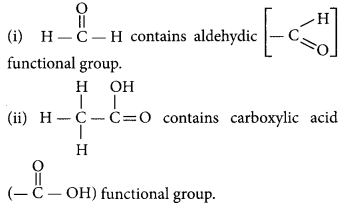
Question 31.
Name the functional group present in each of the following organic compounds:
(i) C2H5Cl
(ii) C2H5OH (Delhi 2012)
Answer:
(i) C2H5Cl contains -Cl (chloro) group which belongs to halo functional group.
(ii) C5H5OH contains -OH group which belongs to alcoholic functional group.
Question 32.
Write the name and formula of the second member of the carbon compounds having functional group -OH. (AI 2012)
Answer:
Those having -OH as functional group belong to alcohol family. Second member of this family is ethanol, C2H5OH.
Question 33.
Write the name and formula of the first member of the series of carbon compounds having functional group (Foreign 2012)
Answer:
Carbon compound containing![]()
group is called carboxylic acid. The first member of this family is methanoic acid (HCOOH).
Question 34.
Butanone is a four-carbon per molecule compound. Name the functional group present in it. (Foreign 2011)
Answer: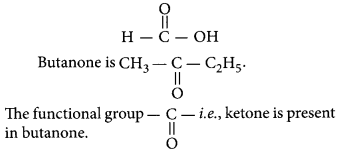
Question 35.
State two properties of carbon which lead to a very large number of carbon compounds. (2/5, AI 2011)
Answer:
Carbon forms a large number of carbon compounds like long chains which may be straight or branched chains or ring of different sizes due to its tetravalency ahd unique property of catenation. Carbon due to its small size forms exceptionally stable compounds by forming strong bonds.
Question 36.
Carbon, a member of group 14, forms a large number of carbon compounds estimated to be about three million. Why is this property not exhibited by other elements of this group? Explain. (2020)
Answer:
Refer to answer 20.
As we move down the group, the element-element bond energies decrease rapidly. For this reason other elements of this group show little or no catenation property.
Question 37.
(a) Why are most carbon compounds poor conductors of electricity?
(b) Write the name and structure of a saturated compound in which the carbon atoms are arranged in a ring. Give the number of single bonds present in this compound. (2018)
Answer:
(a) Due lo catenation, carbon forms covalent bonds with the constituent elements in the carbon compounds, hence it does not have mobile electrons and carbon compounds do not dissociate themselves into ions and hence, they are poor conductor of electricity.
Name: Cyclopentane
Number of single bonds : 15
Question 38.
An aldehyde as well as a ketone can be represented by the same molecular formula, say C3H6O. Write their structures and name them. State the relation between the two in the language of science. (AI 2016)
Answer:
The aldehyde and ketone represented by the
molecular formula, C3H6O.
In the language of science, they are called as isomers because both have same molecular formula but different structural formulae (having different functional groups.)
Question 39.
What is meant by isomers? Draw the structures of two isomers of butane, C4H10. Explain why we cannot have isomers of first three members of alkane series. (Delhi 2015, Foreign 2014)
Answer:
Isomers are those molecules which have the same molecular formula but different structural formula i.e., show different properties.
The structures of possible isomers of butane (C4H10) are: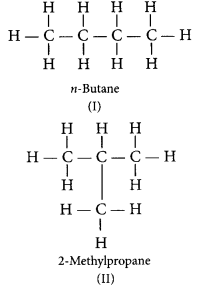
The first three members of alkane series are :
(i) CH4 (methane)
(ii) C2H6 (ethane)
(iii) C3H8 (propane)
In the above members of alkane series, it is not possible to have different arrangements of carbon atoms. Thus, we cannot have isomers of first three members of alkane series.
Question 40.
Write the molecular formula of the following compounds and draw their electron-dot structures:
(i) Ethane
(ii) Ethene
(iii) Ethyne (Foreign 2015)
Answer:
(i) Molecular formula of ethane is C2H6.
Its electron dot structure is :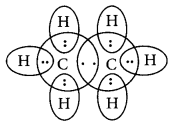
(ii) Molecular formula of ethene is C2H4. Its electron dot structure is :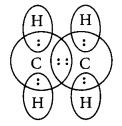
(iii) Molecular formula of ethyne is C2H2. Its electron dot structure is :![]()
Question 41.
What is meant by functional group in carbon compounds? Write in tabular form the structural formula and the functional group present in the following compounds :
(i) Ethanol
(ii) Ethanoic acid (Foreign 2015)
Answer:
Refer to answer 30.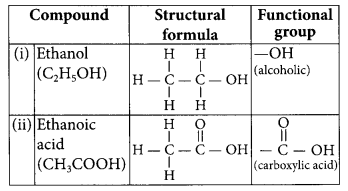
Question 42.
Why is homologous series of carbon compounds so called? Write the chemical formula of two consecutive members of any homologous series and state the part of these compounds that determines their (i) physical and (ii) chemical properties. (Foreign 2015, AI2014, Delhi 2013)
Answer:
Refer to answer 22.
Consecutive members of the homologous series of alcohols are:
The physical properties are determined by alkyl group/hydrocarbon part/part other than the functional group.
The chemical properties are determined by functional group such as -OH group.
Question 43.
State the meaning of functional group in a carbon compound. Write the functional group present in (i) ethanol and (ii) ethanoic acid and also draw their structures. (Delhi 2014)
Answer:
Refer to answer 30 and 41.
Question 44.
State the meaning of the functional group in an organic compound. Write the formula of the functional group present in alcohols, aldehydes, ketones and carboxylic acids. (Delhi 2014)
Answer:
Refer to answer 30.
The formulae for different functional groups are : alcohols : -OH group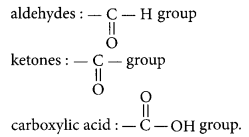
Question 45.
What is meant by homologous series of carbon compounds? Write the general formula of (i) alkenes, and (ii) alkynes. Draw the structures of the first member of each series to show the bonding between the two carbon atoms. (AI 2014)
Answer:
Refer to answer 22.
The general formula for alkenes is CnH2n and for alkynes is CnH2n-2
First member of alkene is ethene, C2H4 and its structure is
First member of alkyne is ethyne, C2H2 and its structure is H – C ≡ C – H
Question 46.
Define the term structural isomerism’. Explain why propane cannot exhibit this property. Draw the structures of possible isomers of butane, C4H10. (AI 2014)
Answer:
Two or more organic compounds having the same molecular formula but different structures, are called structural isomers and the phenomenon is known as structural isomerism.
There is no possible isomers for propane as it contains three carbon atoms and it is not possible to have different arrangements of these carbon atoms.
Refer to answer 39.
Question 47.
(a) What is a homologous series of compounds? List any two of its characteristics. (Foreign 2011)
(b) What is the next higher homologue of C3H7OH? What is its formula and what is it called? (Foreign 2011)
Answer:
(a) Refer to answer 22.
Two characteristics of homologous series are :
(i) The successive compounds of the homologous series differ by -CH2 unit i.e. 14 mass units.
(ii) Each homologous series belongs to similar class of compounds which shows the same chemical properties.
(b) Next higher homologue of C3H7OH is C4H9OH i.e., butanol.
Question 48.
(a) State the reason why carbon can neither form C4+ cations nor C4- anions, but forms covalent bonds. Also state reasons to explain why covalent compounds
(i) are bad conductors of electricity
(ii) have (ow melting and boiling points.
(b) Write the structural formula of benzene, C6H6. (AI2019)
Answer:
(a) Refer to answer 6.
(i) Refer to answer 3.
(ii) Refer to answer 1.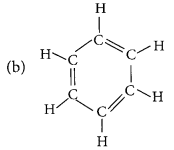
Question 49.
Explain why carbon forms compounds mainly by covalent bond. Explain in brief two main reasons for carbon forming a large number of compounds. Why does carbon form strong bond with most other elements? (Delhi 2015)
Answer:
Refer to answers 6 and 35.
Due to the small size of carbon atom, its nucleus holds the shared pair of electrons between atoms strongly. Thus, carbon forms strong covalent bonds with elements such as hydrogen, oxygen, nitrogen, sulphur, chlorine and other elements.
Question 50.
What are hydrocarbons? Distinguish alkanes from alkenes and each of them from alkynes, giving one example of each. Draw the structure of each compound cited as example to justify your answer. (Foreign 2014)
Answer:
Hydrocarbons are the compounds of carbon and hydrogen atoms. Those hydrocarbons which contain only single carbon-carbon bonds are called alkanes (saturated hydrocarbons) while those having double and triple bonds are called alkenes and alkynes respectively (unsaturated hydrocarbon).
| Alkanes | Alkenes | Alkynes |
| 1. General formula = CnH2n+2 | General formula = CnH2n | General formula = CnH2n-2 |
| 2. Contain C – C single bonds | Contain C = C double bonds | Contain C ≡ C triple bonds |
| 3. e.g., methane (CH4) | e.g., ethene (C2H4) | e.g., ethyne (C2H2) |
Structures of the above examples are: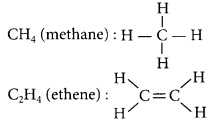
C2H2 (ethyne): H – C ≡ C – H
Question 51.
(a) Define the term‘isomers’.
(b) Draw two possible isomers of the compound with molecular formula C3H6O and write their names.
(c) Give the electron dot structures of the above two compounds. (Delhi 2013)
Answer:
(a) Refer to answer 39.
(b) Two possible isomers of the compound, C3H6O are:
(c) The electron dot structures of propanone and Propanal are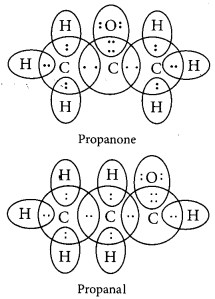
Question 52.
Explain isomerism. State any four characteristics of isomers. Draw the structures of possible isomers of butane, C4H10. (AI 2011)
Answer:
Isomers are those compounds which have same molecular formula but different structures. The phenomenon of existing these isomers are called isomerism.
Four characteristics of isomers are :
(i) They have same molecular formula but different structures.
(ii) For hydrocarbons, isomers is possible only with hydrocarbons having four or more carbon atoms.
(iii) Due to isomerism, a given molecular formula can represent two or more different compounds.
(iv) Due to isomerism, the different compounds have different properties.
Refer to answer 39.
Question 53.
Name the process by which unsaturated fats are changed to saturated fats. (Foreign 2015)
Answer:
Hydrogenation is the process in which unsaturated fats are changed to saturated fats.
Question 54.
Write the chemical equation to show what happen when methane is treated with chlorine in the presence of sunlight ? (1/3, Foreign 2014)
Answer:
When methane is treated with chlorine in the presence of sunlight then substitution reaction takes place. In this, chlorine replaces the hydrogen atom of methane.![]()
Question 55.
Write the respective chemical reaction to show what happens when methane is burnt in presence of oxygen? (1/3, Foreign 2014)
Answer:
When methane is burnt in presence of oxygen then carbon dioxide will be produced.
CH4 + O2 → CO2 + H2O + heat + light
Question 56.
Write one chemical equation to represent the following type of reaction of organic substances: substitution. (1/3, Foreign 2014)
Answer:
Substitution : In this type of reaction one or more hydrogen atoms of a hydrocarbon is replaced by some other atoms.![]()
Question 57.
Give reason for the following : Acetylene burns with a sooty flame. (1/5, Foreign 2011)
Answer:
The formula of acetylene is HC ≡ CH. It is an unsaturated hydrocarbon where carbon content is more than the hydrogen content. Hence, carbon is not completely burnt and the unburnt carbon deposits as a soot.
Question 58.
Give reason for the following : Kerosene does not decolourise bromine water while cooking oils do. (1/5, Foreign 2011)
Answer:
Cooking oils (unsaturated compounds) decolourise bromine water due to formation of addition products whereas kerosene (saturated compound) does not decolourise bromine water.
Question 59.
What happens when 5% alkaline KMnO4 solution is added drop by drop to warm ethanol taken in a test tube? State the role of alkaline KMnO4 solution in this reaction. (2/3, Foreign 2016)
Answer:
When 5% alkaline KMnO4 solution is added drop by drop to warm ethanol then it gets oxidised to ethanoic acid.![]()
Here, alkaline KMnO4 acts as an oxidising agent i.e., the substance which is capable of adding oxygen to others. Thus, alkaline KMnO4 provides oxygen to ethanol to form ethanoic acid.
Question 60.
3 mL of ethanol is taken in a test tube and warmed gently in a water bath. A 5% solution of alkaline potassium permanganate is added first drop by drop to this solution, then in excess.
(i) How is 5% solution of KMnO4 prepared?
(ii) State the role of alkaline potassium permanganate in this reaction. What happens on adding it in excess?
(iii) Write chemical equation of this reaction. (2020)
Answer:
(i) 5% solution of KMnO4 is prepared by adding 5 g of KMnO4 in 95 g of water.
(ii) Here alkaline KMnO4 acts as an oxidising agent. It oxidises ethanol to ethanoic acid by donating nascent oxygen. If excess of KMnO4 is added the purple colour will persist indicating no more alcohol is left and there is no reaction.![]()
Question 61.
Two carbon compounds X and Y have the molecular formula C4H8 and C5H12 respectively. Which one of these is most likely to show addition reaction? Justify your answer. Also give the chemical equation to explain the process of addition reaction in this case. (Delhi 2017)
Answer:
All unsaturated hydrocarbons (containing double or triple bonds) have tendency to get converted to saturated hydrocarbons (single bonds) by adding small molecules such as hydrogen (H2), halogens (X2), etc. Such reactions are called addition reactions.
Compound X i.e., C4H8 belongs to alkene series (CnH2n) while compound Y i.e., C5H12 belongs to alkane series (CnH2n+2). Thus, compound X will undergo addition reaction.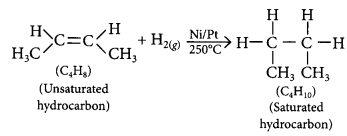
Question 62.
The molecular formula of two carbon compounds are C4H8 and C3H8. Which one of the two is most likely to show addition reaction? Justify your answer. Also give the chemical equation to explain the process of addition reaction in this case. (Delhi 2017)
Answer:
C3H8 belongs to alkane series (CnH2n+2) Refer to answer 61.
Question 63.
What is an oxidising agent? What happens when an oxidising agent is added to propanol? Explain with the help of a chemical equation. (Delhi 2016)
Answer:
The substance that supply oxygen in a reaction for oxidation is called oxidising agent e.g., potassium permanganate, potassium dichromate, etc.
When propanol is heated with alkaline KMnO4, it gets oxidised to propanoic acid.
Question 64.
Draw the electron-dot structure for ethyne. A mixture of ethyne and oxygen is burnt for welding. In your opinion, why cannot we use a mixture of ethyne and air for this purpose? (AI 2015)
Answer:
The formula for ethyne is C2H2 and its electron dot structure is :
A mixture of ethyne and oxygen is burnt for welding so that complete oxidation of ethyne takes place. If in place of oxygen, air is taken which contains less amount of oxygen then incomplete combustion of oxygen takes place and temperature required for welding will not be attained.
Question 65.
Write the name and general formula of a chain of hydrocarbons in which an addition reaction with hydrogen is possible. State the essential condition for an addition reaction. Stating this condition, write a chemical equation giving the name of the reactant and the product of the reaction. (AI 2015, Delhi 2014)
Answer:
Alkenes, having general formula as CnH2n and alkynes, having general formula as CnH2n-2 are the class of hydrocarbons in which addition reaction is possible.
The essential conditions for addition reaction are :
(i) Presence of unsaturated hydrocarbon.
(ii) Presence of catalyst such as Ni/Pt/Pd.
Let us take an example of ethene. It undergoes addition reaction with hydrogen when it is heated in the presence of nickel catalyst to form ethane. The reaction is known as hydrogenation.
Question 66.
Why are certain compounds called hydrocarbons? Write the general formula for homologous series of alkanes, alkenes and alkynes and also draw the structure of the first member of each series. Write the name of the reaction that converts alkenes into alkanes and also write a chemical equation to show the necessary conditions for the reaction to occur. (AI 2017)
Answer:
Refer to answers 50 and 65.
Question 67.
What are hydrocarbons? Write the name and general formula of
(i) saturated hydrocarbons
(ii) unsaturated hydrocarbons, and draw the structure of one hydrocarbon of each type. How can an unsaturated hydrocarbon be made saturated? (AI 2012)
Answer:
Refer to answer 50.
Unsaturated hydrocarbons can be made to saturated hydrocarbons by hydrogenation reaction using nickel (Ni) as a catalyst.
Question 68.
(a) With the help of a suitable example, explain the process of hydrogenation mentioning the conditions of the reaction and any one change in physical property with the formation of the product. (Delhi 2015, 2013, Foreign 2012)
(b) How does a saturated hydrocarbon react with chlorine? Write chemical equation for it. What type of reaction is it called and why? (Foreign 2012)
Answer:![]()
groups that can be hydrogenated.
Hydrogenation is the addition of hydrogen to an unsaturated hydrocarbon to obtain a saturated hydrocarbon.
Here R can be any alkyl group.
There is the change of unsaturated compound from the liquid state to saturated compound in the solid state thus, melting point increases.
(b) Saturated hydrocarbon reacts with chlorine to form a substituted product, e.g.,
This reaction is called substitution reaction as here one hydrogen of methane is substituted by one chlorine atom.
Question 69.
Assertion (A) : Esterification is a process in which a sweet smelling substance is produced.
Reason (R): When esters react with sodium hydroxide, an alcohol and sodium salt of carboxylic acid are obtained.
(a) Both (A) and (R) are true and (R) is the correct explanation of the assertion (A).
(b) Both (A) and (R) are true, but (R) is not the correct explanation of the assertion (A).
(c) (A) is true, but (R) is false.
(d) (A) is false, but (R) is true. (2020)
Answer:
(b): When an ester reacts with the base saponification reaction occurs.
Question 70.
Assertion (A) : Ethanoic acid is also known as glacial acetic acid.
Reason (R) : The melting point of pure ethanoic acid is 290 K and hence it often freezes during winters in cold climates.
(a) Both (A) and (R) are true and (R) is the correct explanation of the assertion (A).
(b) Both (A) and (R) are true, but (R) is not the correct explanation of the assertion (A).
(c) (A) is true, but (R) is false.
(d) (A) is false, but (R) is true. (2020)
Answer:
(a): Pure ethanoic acid or acetic acid freezes below room temperature into white crystals that resemble glaciers.
Question 71.
Draw the structure for ethanoic acid molecule, CH3COOH. (AI 2011)
Answer:
Structure of ethanoic acid is
Question 72.
A compound ‘X’ on heating with excess cone, sulphuric acid at 443 K gives an unsaturated compound ‘Y’. ‘X’ also reacts with sodium metal to evolve a colourless gas ‘Z’. Identify ‘X’, ‘Y’ and ‘Z’. Write the equation of the chemical reaction of formation of ‘Y’ and also write the role of sulphuric acid in the reaction. (2018)
Answer:
As X reads with cone. H2SO4 to give an alkene so it should be an alcohol as cone. H2SO4 acts as a dehydrating agent. The reaction of X with Na also confirms that it is an alcohol because alcohols react with Na metal to evolve colourless hydrogen gas.![]()
Here, conc. H2SO4 acts as a dehydrating agent i.e., helps in the removal of water.
Question 73.
Write the chemical equations to show what happens when
(i) an ester reacts with a base?
(ii) ethanol reacts with ethanoic acid in the presence of sulphuric acid? (2/3, Foreign 2014)
Answer:
(i) When an ester reacts with the base then it gives sodium salt of carboxylic acid and an alcohol. It is known as saponification reaction.
(ii) Carboxylic acids react with alcohols in the presence of a little concentrated sulphuric acid to form pleasant smelling esters. This reaction is called esterification reaction.
Question 74.
Write the respective chemical equations to show what happens when
(i) ethanol is heated with concentrated sulphuric acid at 443 K ?
(ii) ethanol reacts with ethanoic acid in the presence of an acid acting as a catalyst? (2/3, Foreign 2014)
Answer:
(ii) Refer to answer 73(ii).
Question 75.
Write one chemical equation to represent each of the following types of reactions of organic substances:
(i) Esterification
(ii) Saponification (2/3, Delhi 2011)
Answer:
(i) Refer to answer 73(ii).
(ii) Refer to answer 73(i).
Question 76.
Complete the following chemical equations : (Delhi 2017)
(i) CH3COOC2H5 + NaOH →
(ii) CH3COOH + NaOH →![]()
Answer: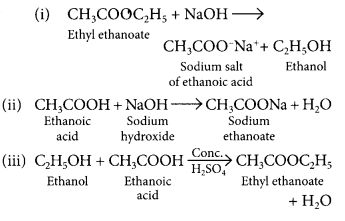
Question 77.
Complete the following chemical equations: (Delhi 2017)
(i) C2H5OH + O2 →![]()
(iii) CH3COOH + NaHCO3 →
Answer:
(ii) Refer to answer 74(i).
Question 78.
Write the structural formula of ethanol. What happens when it is heated with excess of cone. H2SO4 at 443 K? Write the chemical equation for the reaction stating the role of cone. H2SO4 in this reaction. (AI 2017, Delhi 2015, 2013)
Answer:
The structural formula of ethanol (C2H5OH) is
When ethanol is heated with conc. H2SO4 at 443 K then it looses a water molecule to form unsaturated alkene (ethene) as a product.![]()
Here conc. H2SO4 acts as a dehydrating agent i.e., helps in the removal of water.
Question 79.
What happens when (write chemical equation in each case)
(a) ethanol is burnt in air?
(b) ethanol is heated with excess cone. H2SO4 at 443 K?
(c) a piece of sodium is dropped into ethanol? (AI 2017)
Answer:
(a) Refer to answer 77(i).
(b) Refer to answer 74(i).
(c) When a small piece of sodium is dropped into ethanol then hydrogen gas is liberated which burns with a pop sound.
2C2H5OH + 2Na → 2C2H5O–Na+ + H2 ↑
Question 80.
Distinguish between esterification and saponification reaction with the help of the chemical equations for each. State one use of each (i) esters, and (ii) saponification process. (AI 2017, Foreign 2012)
Answer: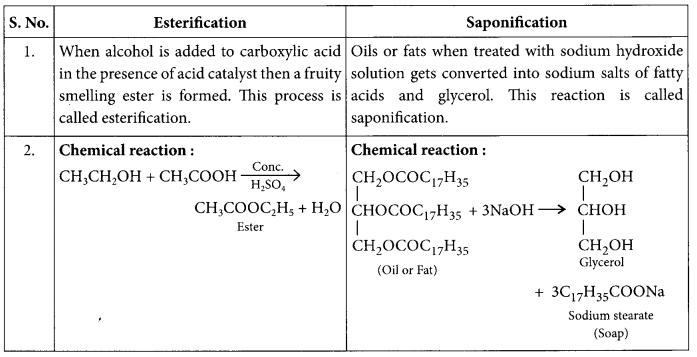
Use of esters: They are used for making perfumes or used as artificial flavouring substances.
Use of saponification process : This process is used in making soaps.
Question 81.
Explain esterification reaction with the help of a chemical equation. Describe an activity to show esterification. (AI 2017)
Answer:
Refer to answer 80.
Aim : To demonstrate esterification process using ethanol and acetic acid.
Materials required : Beaker, water, test tube, ethanol, acetic acid, cone. H2SO4, tripod stand, burner, wire gauze, etc.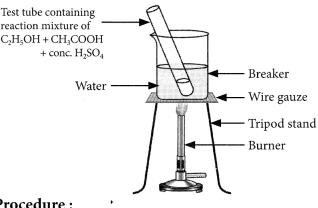
Procedure:
– Take 2 mL of ethanol in a test tube.
– Take 2 mL of ethanoic acid (acetic acid) into it.
– Add few drops of cone. H2SO4
– Warm it in a beaker containing water.
– Observe the smell of the products formed. Observations: Pleasant fruity smelling compound (called ester) is formed.
Chemical reaction:
Conclusion : Carboxylic acid reacts with alcohol in presence of cone. H2SO4 which acts as a dehydrating agent to form esters.
Question 82.
When ethanol reacts with ethanoic acid in the presence of cone. H2SO4, a substance with fruity smell is produced. Answer the following:
(i) State the class of compounds to which the fruity smelling compounds belong. Write the chemical equation for the reaction and write the chemical name of the product formed.
(ii) State the role of cone. H2SO4 in this reaction. (Delhi 2016)
Answer:
(i) When ethanol reacts with ethanoic acid in presence of cone. H2SO4, ethyl ethanoate is formed which belongs to the class of ester compounds, having fruity smell.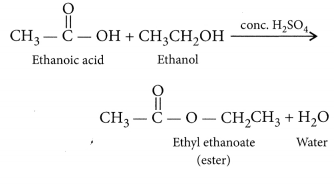
(ii) The above reaction is called esterification which occurs in presence of cone. H2SO4 which acts as a dehydrating agent and helps in the removal of water. Cone. H2SO4 also acts as a catalyst to speed up the reaction.
Question 83.
Name the compound formed when ethanol is heated in excess of cone, sulphuric acid at 443 K. Also write the chemical equation of the reaction stating the role of cone, sulphuric acid in it. What would happen if hydrogen is added to the product of this reaction in the presence of catalyst such as palladium or nickel? (Delhi 2016, Foreign 2015)
Answer:
Refer to answer 78.
If hydrogen is added to ethene in presence of palladium or nickel catalyst then one atom of hydrogen adds to each carbon atom of ethene to form ethane.![]()
Question 84.
Write chemical equation of the reaction of ethanoic acid with the following :
(a) Sodium;
(b) Sodium hydroxide;
(c) Ethanol
Write the name of one main product of each reaction. (AI 2016)
Answer:
Ethanoic acid reacts with sodium as well as sodium hydroxide to form sodium ethanoate.
(b) Refer to answer 76(ii).
(c) Refer to answer 76(iii).
Question 85.
On dropping a small piece of sodium in a test tube containing carbon compound ‘X’ with molecular formula C2H6O, a brisk effervescence is observed and a gas ‘Y’ is produced. On bringing a burning splinter at the mouth of the test tube the gas evolved burns with a pop sound. Identify ‘X’ and ‘Y’. Also write the chemical equation for the reaction. Write the name and structure of the product formed, when you heat ‘X’ with excess cone, sulphuric acid. (AI 2016)
Answer:
Ethanol reacts with sodium to form sodium ethoxide and hydrogen gas is liberated which burns with a pop sound.
Thus, compound X is ethanol and gas Y is hydrogen gas.
When ethanol is heated with excess of concentrated sulphuric acid then it gets dehydrated to form ethene.![]()
Question 86.
Write three different chemical reactions showing the conversion of ethanoic acid to sodium ethanoate. Write balanced chemical equation in each case. Write the name of the reactants and the products other than ethanoic acid and sodium ethanoate in each case. (AI 2016)
Answer:
Ethanoic acid reacts with Na2CO3 to form sodium ethanoate and CO2 gas is liberated.
With sodium hydrogen carbonate it forms sodium ethanoate.
With NaOH it forms sodium ethanoate.
Question 87.
Write the nam e and molecular formula of an organic compound having its name suffixed with ‘ol’ and having two carbon atoms in its molecule. Write balanced chemical equation to indicate what happens when this compound is heated with excess cone. H2SO4 and the narpe of main product formed. Also state the role of cone. H2SO4 in the reaction. (Foreign 2016)
Answer:
Those organic compounds having suffix ‘oF are alcohols. As the alcohol is having two carbon atoms in its molecule so, it is ethanol.
Refer to answer 78.
Question 88.
An organic compound ‘P’ is a constituent of wine. ‘P’ on reacting with acidified K2Cr2O7 forms another compound ‘Q’. When a piece of sodium is added to ‘Q’, a gas ‘R’ evolves which burns with a pop sound. Identify P, Q and R and write the chemical equations of the reactions involved. (Foreign 2016)
Answer:
‘P’ is ethanol which is a constituent of wine. Ethanol on reacting with acidified potassium dichromate (K2Cr2O7) solution gives ethanoic acid ‘Q’.
When a piece of sodium is added to ethanoic acid then sodium salt of ethanoic acid is formed with the liberation of hydrogen gas which burns with a pop sound.
Question 89.
List two tests for experimentally distinguishing between an alcohol and a carboxylic acid and describe how these tests are performed. (AI 2015)
Answer:
Tests for distinguishing between an alcohol and a carboxylic acid are :
(i) Litmus test : When we place a drop of carboxylic acid on blue litmus paper it turns red while alcohol will not change the colour of blue litmus paper.
(ii) Sodium hydrogen carbonate test/sodium carbonate test: If a pinch of NaHCO3 or Na2CO3 is added to two test tubes containing alcohol and carboxylic acid respectively, then test tube containing carboxylic acid will show the evolution of colourless gas with brisk effervescence while test tube containing alcohol does not show any reaction.
Question 90.
What are esters? How are they prepared? List two uses of esters. (Delhi 2014)
Answer:
Esters are generally volatile liquids which have pleasant fruity smell.
Esters are prepared when a carboxylic acid reacts with an alcohol in the presence of small amount of concentrated H2SO4. For example, when ethanoic acid reacts with ethanol it forms an ester (i.e. ethyl ethanoate).
Uses of ester:
1. It is used in making perfumes.
2. It is used in making artificial flavours and essences used in ice-creams, sweets and cold drinks.
Question 91.
A carboxylic acid (molecular formula, C2H4O2) reacts with an alcohol in the presence of an acid catalyst to form a compound ‘X’. The alcohol on oxidation with alkaline KMnO4 followed by acidification gives the same carboxylic acid C2H4O2. Write the name and structure of (i) carboxylic acid, (ii) alcohol and (iii) the compound ‘X’ (AI 2014)
Answer:
The molecular formula of carboxylic acid is C2H4O2. Thus, it should be acetic acid (ethanoic acid).
It reacts with alcohol in presence of acid catalyst to give compound ‘X’.
As alcohol on oxidation with alkaline KMnO4 gives the same acid i.e. ethanoic acid, hence alcohol must contain two carbon atoms. Thus, formula for alcohol is CH3CH2OH i.e. ethanol.
Reactions involved are: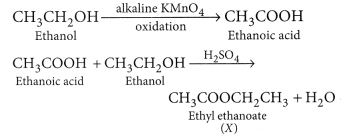
(i) Structure of ethanoic acid :
(ii) Structure of ethanol:
(iii) Structure of ethyl ethanoate (X):
Question 92.
Write the chemical equation to explain what happens when ethanol is heated with alkaline solution, of potassium permanganate. Mention two physical properties and two uses of ethanol. (Foreign 2014)
Answer:
When ethanol is heated with alkaline solution of potassium permanganate then oxidation of ethanol takes place to form ethanoic acid.
Two physical properties of ethanol are:
1. It is liquid at room temperature.
2. It is soluble in water in all proportions.
Two uses of ethanol are :
1. It is used as a liquor for drinking purpose.
2. It is a good solvent and hence, it is used in medicines such as tincture of iodine, cough syrup and many tonics.
Question 93.
Write chemical equations to describe two examples of different oxidations of ethanol. List two uses of ethanol. (Foreign 2014)
Answer:
Addition of oxygen to any substance is called oxidation.
Ethanol gets oxidised to ethanoic acid as :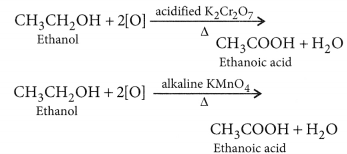
Refer to answer 92.
Question 94.
Write the chemical equations to show what happens when
(i) sodium hydroxide is added to ethanoic acid?
(ii) solid sodium hydrogen carbonate is added to ethanoic acid?
(iii) ethanol reacts with sodium? (Foreign 2014)
Answer:
(i) Refer to answer 76(ii).
(ii) Refer to answer 77(iii).
(iii) Refer to answer 79(c).
Question 95.
Write chemical equations for what happens when
(i) sodium metal is added to ethanoic acid?
(ii) solid sodium carbonate is added to ethanoic acid?
(iii) ethanoic acid reacts with a dilute solution of sodium hydroxide? (AI 2011)
Answer:
(i) Refer to answer 84(a).
(ii) Refer to answer 86.
(iii) Refer to answer 76(ii).
Question 96.
(a) What is a homologous series? Explain with an example.
(b) Define the following terms giving one example of each.
(i) Esterification (ii) Addition reaction (2020)
Answer:
(a) Refer to answer 22.
For example, alkane series has general formula CnH2n + 2.
First member of homologous series of alkane is .methane, i.e., CH4.
Second member of homologous series of alkane is ethane, i.e., C2H6.
Third member of homologous series of alkane is propane i.e., C3H8.
(b) (i) Refer to answer 73(ii).
(ii) Addition reactions : Those reactions in which atoms or group of atoms are simply added to a double or triple bond without the elimination of any atom or molecule, are known as addition reactions.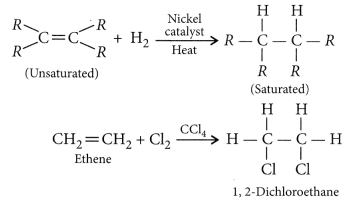
Question 97.
(a) Carry out following conversions :
(i) Ethanol to ethene
(ii) Ethanol to ethanoic acid
(b) Differentiate between addition reaction and substitution reaction. Give one example of each. (2020)
Answer:
(a) (i) When ethanol is heated with cone. H2SO4 at 443 K, ethene is obtained due to dehydration of ethanol.
(ii) When 5 % alkaline KMnO4 solution is added drop by drop to warm ethanol then it gets oxidised to ethanoic acid.![]()
(b) Refer to answer 96(ii).
Substitution reactions : The reactions which involve the displacement or substitution of an atom or a group of atoms in an organic compound by another atom or group of atoms, are known as substitution reactions.
Saturated hydrocarbons are fairly unreactive and inert in the presence of most of the reagents. However, in presence of sunlight, hydrocarbons undergo rapid substitution reactions, e.g.,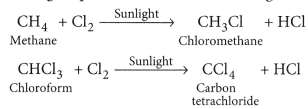
Question 98.
Write the chemical formula and name of the compound which is the active ingredient of all alcoholic drinks. List its two uses. Write chemical equation and name of the product formed when this compound reacts with
(i) sodium metal
(ii) hot concentrated sulphuric acid. (Delhi 2019)
Answer:
Ethanol having chemical formula C2H5OH is the active ingredient of all alcoholic drinks.
Uses of ethanol:
1. Ethanol is widely used in industry as a solvent.
2. Ethanol is used as an antiseptic for wounds in the form of rectified spirit.
Chemical equations:
(i) Refer to answer 79(c).
(ii) Refer to answer 74(i).
Question 99.
(a) Define the term isomer.
(b) Two compounds have same molecular formula C3H6O. Write the name of these compounds and their structural formula.
(c) How would you bring the following conversions:
(i) Ethanol to ethene
(ii) Propanol to propanoic acid? (AI 2019)
Answer:
(a) Refer to answer 39.
(b) Refer to answer 51 (b).
(c) (i) Refer to answer 97(a)(i).
Question 100.
A carbon compound ‘P’ on heating with excess cone. H2SO4 forms another carbon compound ‘Q’ which on addition of hydrogen in the presence of nickel catalyst forms a saturated carbon compound ‘R’ One molecule of ‘R’ on combustion forms two molecules of carbon dioxide and three molecules of water. Identify P, Q and R and write chemical equations for the reactions involved. (AI 2016)
Answer:
When ethanol is heated with excess of concentrated H2SO4 it gets dehydrated to form ethene.
When ethene is heated with hydrogen in presence of nickel catalyst it forms ethane.
Ethane on oxidation gives two moles of carbon dioxide and three moles of water.
CH3CH3 +
Question 101.
List in tabular form three physical and two chemical properties on the basis of which ethanol and ethanoic acid can be differentiated. (Delhi 2012)
Answer:
| Ethanoic acid (Physical properties) | Ethanol (Physical properties) |
| (i) It has moderate melting point (290 K) and boiling point (391 K). | It has very low melting point (156 K) and low boiling point (351 K). |
| (ii) It has a sour taste. | It has a burning taste. |
| (iii) It has a pungent smell. | It has a distinct smell. |
(ii)
| Chemical properties | Chemical properties |
| (i) It is acidic in nature and turns blue litmus to red. | It is neutral in nature and thus, it does not turn blue litmus to red or vice-versa. |
| (ii) Ethanoic acid reacts with Na2CO3 or NaHCO3 to give brisk effervescence of CO2 gas. 2CH3COOH + Na2CO3 → 2CH3COONa + CO2 ↑+ H2O | Ethanol does not react with Na2CO3 or NaHCO3, C2H5OH + Na2CO3 → No reaction |
Question 102.
(a) In a tabular form, differentiate between ethanol and ethanoic acid under the following heads:
(i) Physical state
(ii) Taste
(iii) NaHCO3 test
(iv) Ester test
(b) Write a chemical reaction to show the dehydration of ethanol. (Delhi 2011)
Answer:
(a)
(b) Refer to answer 97(a)(i).
Question 103.
Several factories were pouring their wastes in rivers A and B. Water samples were collected from these two rivers. It was observed that sample collected from river A was acidic while that of river B was basic. The factories located near A and B are
(a) Soaps and detergents factories near A and alcohol distillery near B.
(b) Soaps and detergents factories near B and alcohol distillery near A.
(c) Lead storage battery manufacturing factories near A and soaps and detergents factories near B.
(d) Lead storage battery manufacturing factories near B and soaps and detergents factories near A. (2020)
Answer:
(c) Lead storage battery manufacturing factories near A and soaps and detergents factories near B.
Question 104.
Why does micelle formation take place when soap is added to water? Why are micelles not formed when soap is added to ethanol? (3/5, AI 2011)
Answer:
A soap molecule has two ends with different properties, one end is polar i.e., water soluble or hydrophilic while other end is non-polar i.e., water insoluble or hydrophobic. When soap is added to water, the polar ends get dissolve in water and non-polar ends get dissolved in each other and directed towards the centre. As a result, a spherical ionic molecule known as micelles, formation takes place. Since, soaps are soluble in ethanol, therefore, micelles formation does not occur.
Question 105.
Soaps and detergents are both, types of salts. State the difference between the two. Write the mechanism of the cleansing action of soaps. Why do soaps not form lather (foam) with hard water? Mention any two problems that arise due to the use of detergents instead of soaps. (Delhi 2017, AI 2015)
Answer:
Soaps are the sodium or potassium salts of higher fatty acids. The ionic group in soaps is -COO–Na+.
On the other hand, synthetic detergents are the sodium salts of a long chain alkylbenzenesulphonic acids or long chain alkyl hydrogen sulphates. The ionic group in synthetic detergents is
-SO3– Na+ or -OSO3 –Na+
Cleansing action of soap :
A soap molecule contains a polar part (COO–Na+) called polar end and a non-polar part consisting of a long chain carbon atoms. This part is called hydrocarbon end.
The polar end is water soluble whereas hydrocarbon part is water-repellent and oil soluble.
When an oily (dirty) piece of cloth is put into soap solution, the hydrocarbon part of the molecule attaches itself to the oily drop and the -COO– end orients itself towards water. Na+ ions in solution arrange themselves around the -COO– ions. The negatively charged micelle so formed entraps the oily dirt. The negatively charged micelle repel each other due to the electrostatic repulsion. As a result, the tiny oily dirt particles do not come together and get washed away in water during rinsing.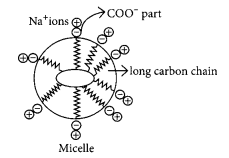
In hard water, soap does not form lather as hard water contains Ca2+and Mg2+ ions. Soap reacts with these ions to form insoluble calcium and magnesium salts of fatty acids.![]()
Two problems which arise due to the use of detergents instead of soaps are :
(i) Synthetic detergents are non-biodegradable and hence, cause water pollution.
(ii) Synthetic detergents also cause skin related problems.
Question 106.
What are micelles? Why does it form when soap is added to water? Will a micelle be formed in other solvents such as ethanol also? State briefly how the formation of micelles help to clean the clothes having oily spots. (Foreign 2016)
Answer:
Refer to answer 104.
Refer to answer 105.
Question 107.
(a) You have three unlabelled test tubes containing ethanol, ethanoic acid and soap solution. Explain the method you would use to identify the compounds in different test tubes by chemical tests using litmus paper and sodium metal.
(b) Give the reason of formation of scum when soaps are used with hard water. (Foreign 2016)
Answer:
(a) The tests may be tabulated as below:
| s.no. | Solution | Blue litmus paper | Red litmus paper | Sodium Metal |
| 1. | Ethanol | No change | No change | Hydrogen gas |
| 2. | Ethanoic acid | Turns red | No change | Hydrogen gas |
| 3. | Soap solution | No change | Turns blue | No reaction |
(b) Hard water contains hydrogen carbonates, chlorides and sulphates of calcium and magnesium. When soap is added to hard water it reacts with these salts to form scum which is insoluble in water and floats on the top of the water surface. The scum is formed due to the formation of insoluble calcium or magnesium salts of fatty acids.
Question 108.
What is the difference between the molecules of soaps and detergents, chemically? Explain the cleansing action of soaps. (Delhi 2015)
Answer:
Refer to answer 105.
Question 109.
What is the difference between the chemical composition of soaps and detergents? State in brief the action of soaps in removing an oily spot from a shirt. Why are soaps not considered suitable for washing where water is hard? (Delhi 2012)
Answer:
Refer to answers 105 and 107(b).
Question 110.
What are detergents chemically? List two merits and two demerits of using detergents for cleansing. State the reason for the suitability of detergents for washing, even in the case of water having calcium and magnesium ions. (AI 2012)
Answer:
Detergents are generally ammonium or sulphonate or sulphate salts of long chain carboxylic acids. The more common detergents are sodium salts of long chain alkyl benzene sulphonic acids.
Merits of using detergents :
(i) Detergents are very strong cleansing agents.
(ii) They can form lather well even in hard water as they do not form insoluble calcium or magnesium salts.
Demerits of using detergents :
(i) As detergents are sodium salts of long chain alkyl benzene sulphonic acids which are very bulky molecules, are not easily degraded by bacteria and hence, they are non-biodegradable.
(ii) They are highly basic in nature and cause damage to skin.
Synthetic detergents can be used even in hard water because they do not react with Ca2+ and Mg2+ ions present in hard water. They do not form curdy white precipitates (scum) of calcium and magnesium salts of fatty acids.
Question 111.
What are soaps and detergents chemically? Explain the action of cleaning by soaps. State the reason why we can wash our clothes even in hard water using detergents. (Foreign 2012)
Answer:
Refer to answers 105 and 110.
Question 112.
(a) What is a soap? Why are soaps not suitable for washing clothes when the water is hard?
(b) Explain the action of soap in removing an oily spot from a piece of cloth. (Delhi 2011)
Answer:
(a) Refer to answers 105 and 107(b).
(b) Refer to answer 105.
Question 113.
(a) What is a detergent? Name one detergent.
(b) Write two advantages and two dis-advantages of using detergents over soaps.
(c) Why, by using a detergent, can we wash clothes even in hard water?
Answer:
(a) Detergents are ammonium or sulphonate or sulphate salts of long chain hydrocarbons containing 12-18 carbon atoms e.g., dodecyl benzene sulphonate.
(b) Refer to answer 110.
(c) Refer to answer 110.










